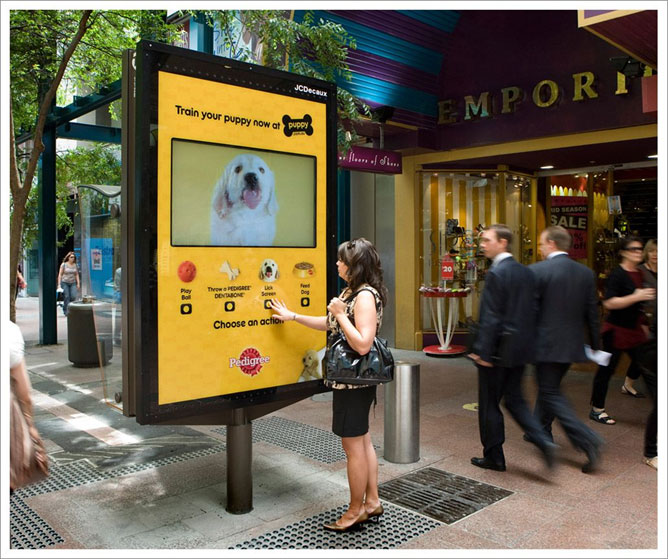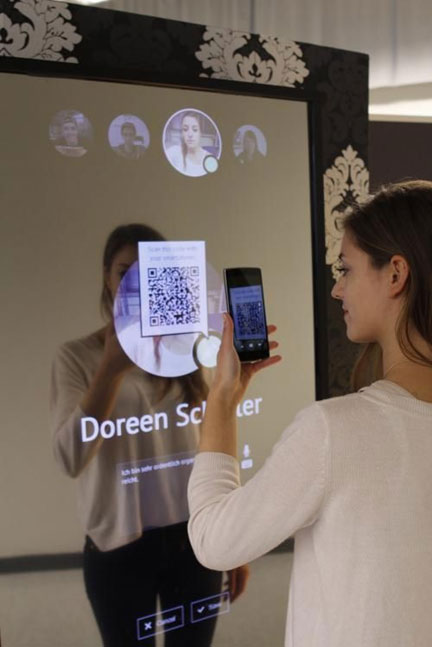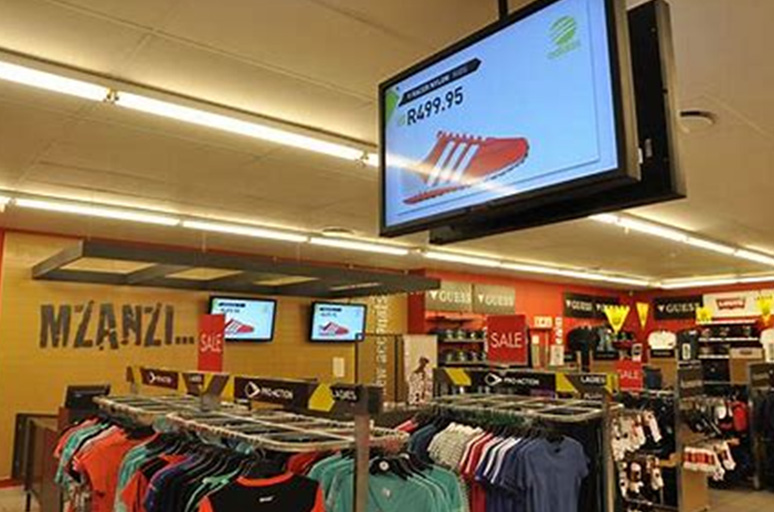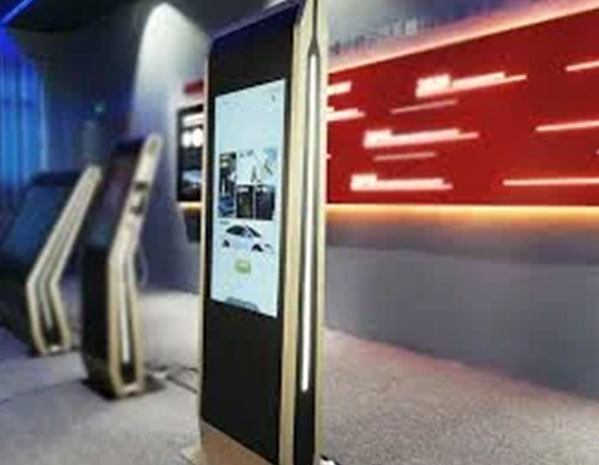Digital OOH (out-of-home) advertising is a dynamic and high-impact form of advertising that utilizes digital screens, often placed in public spaces like malls, airports, and transit stations, to deliver marketing messages to a wide audience.
Unlike traditional static billboards, digital OOH allows for the display of a variety of content, including images, videos, animations, and even real-time information, making it a versatile and attention-grabbing medium for companies in various countries including India, Canada, US, Middle East.
Now, in this article, we will explore how dynamic content can enhance your advertising efforts and engage your audience in ways that traditional static ads simply can’t. So, let’s get started!
#1 Data-driven content helps personalize campaigns
Data-driven content involves using real-time data to tailor your DOOH campaign messages and visuals. The objective is to make your content not only relevant but also timely so it aligns with the needs and preferences of your target audience at any given moment.
Google’s “Make the Most of Summer” campaign is a great example of implementing data-driven DOOH campaigns. The advertisers understood the fascination of British people with the weather. So, it depicted various seasonal search terms and their responses. The campaign was a hit, and it’s all about understanding what your target customers want to see.
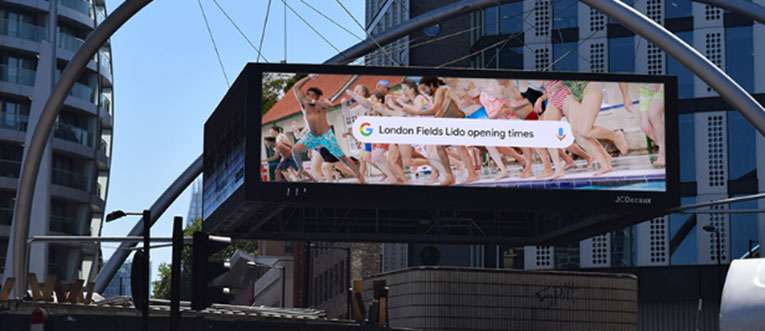
Let’s look at some ways you can utilize data-driven content in your DOOH campaigns:
- Leverage local data
Understand your audience’s local context. Consider variables like weather, traffic, and local events, and adapt your content accordingly.McDonald’s UK campaign is a great example of how you can use weather information to promote your products. The campaign used weather data to advertise its seasonal drinks- strawberry lemonade and millionaire’s frappe. When the temperature rose above 25 degrees, here’s what the digital signage displayed:

- Demographic insights
Use data to tailor your content based on the demographics of the viewers in the vicinity. You might want to show different products or messaging to young adults versus families or seniors. - Real-time updates
Ensure your content management system is capable of real-time updates. If there’s a sudden change in the environment, your content should reflect it immediately. For instance, a food delivery service can adjust delivery times during peak traffic hours. - A/B testing
Continuously test different content variations and track their performance. A/B testing can help you understand what resonates most with your audience, allowing you to fine-tune your content strategy.
Pro tip: Create content templates that can be easily customized with real-time data. This allows you to maintain a consistent brand identity while adapting to changing conditions.
#2 Audiences cannot resist Interactive experiences
Interactive experiences in OOH advertising involve enabling viewers to engage with your content actively. This can take various forms, such as touchscreens, QR codes, mobile integrations, or other mechanisms that encourage viewers to interact with the display. The goal is to create a memorable and engaging connection between the audience and your brand.

To ensure you provide interactive experiences, here are a few things you can follow:
- Clear Call-to-Action (CTA)
Make it unmistakably clear what viewers need to do to interact with your content. Whether it’s touching the screen, scanning a QR code, or using their mobile device, a well-placed and concise CTA is essential. - Incentivize interaction
Provide an incentive for interaction. Offer discounts, exclusive content, or the chance to win prizes to motivate viewers to engage with your campaign. - Mobile integration
Leverage viewers’ smartphones by integrating them into your campaign. For instance, using NFC technology to enable instant connections to a website or app can be a seamless and familiar way to engage. - Content Variety
Offer a diverse range of interactive content. Polls, quizzes, games, and product configurators can all enhance engagement. Keep the content fresh and regularly update it to encourage repeat visits.
Learn more: Top Trends in DOOH Advertising in 2024
#3 Storytelling helps develop an emotional connect
OOH advertising campaigns should not just display products; they should tell a story. Storytelling captivates the audience’s emotions and creates a connection. Use sequential ads to narrate a story, reveal the benefits of a product or service, and maintain suspense. The human brain is naturally wired to respond to narratives, making this an effective engagement strategy.
Here are some tips to incorporate storytelling in your digital OOH campaigns:
- Start with a hook
Begin your narrative with a compelling and attention-grabbing message. Think of it as the opening scene of a movie that draws viewers in. - Sequential messaging
Plan a sequence of messages that build on one another, creating a narrative flow. For instance, a car advertisement could start by highlighting fuel efficiency, then move to safety features, and finally, showcase the car in action. - Emotional appeal
Use storytelling to evoke emotions. Whether it’s humor, nostalgia, empathy, or excitement, emotional content is more likely to resonate with viewers.
When it comes to creating an emotional connection, the Ad Council did a brilliant job with this DOOH campaign:

The campaign ran during COVID-19 and thanked all essential workers for their services. All these ads were strategically placed outside hospitals, grocery stores, and highways.
- Audience connection
Understand your audience’s values and interests. Tailor your narrative to resonate with them, whether that means appealing to their aspirations, fears, or desires.
Pro tip: Focus on multichannel integration and consider how your DOOH narrative fits into your overall marketing strategy. How can it connect with other channels, such as social media or online advertising, to create a consistent story?
#4 Location-based targeting increases relevance
Location-based targeting in OOH advertising involves tailoring content to the specific geographic location of the digital displays. This approach leverages the power of GPS technology and data analysis to deliver messages that are contextually relevant to the audience in a particular area, such as a neighborhood, city, or even a specific street
corner.
For instance, New York City’s Times Square is one of the best spots for running DOOH ads. Take CVS’s #beautyunaltered campaign, for example. The campaign motivated users to upload their unedited selfies, and the digital signage showed these images. As a result, CVS Beauty earned over 3.6 Billion impressions. Such results were achieved because of the focus on high-profile locations and dynamic user-generated content.

If you want to achieve such results, here are a few things you should focus on:
- Audience segmentation
Divide your target audience into segments based on their geographical location. Understand the unique preferences and needs of each segment to deliver content that resonates with them. - Geo-fencing
Implement geofencing to define specific geographic areas where your content will be displayed. This allows for precise targeting, ensuring that your message reaches the intended audience. - Localized language and culture
Adapt your content to the local language and culture. Ensure that your message is not only geographically relevant but also culturally sensitive.
Pro tip: digital signage solutions can help here with precise location-based targeting by allowing advertisers to remotely manage and adapt the content in real-time, ensuring the right message is displayed to the right audience at the right location.
#5 Social media integration helps spread the message
Social media integration in digital OOH advertising involves incorporating elements from popular social platforms, such as live social media feeds, user-generated content, hashtags, and social sharing mechanisms, into your DOOH campaigns. This approach allows you to leverage the massive audiences of social media to amplify the reach and engagement of your messages.

Here’s how you can use it to your best advantage:
- User-generated content
Encourage viewers to create and share content related to your campaign. Display user-generated photos, reviews, or posts on your DOOH screens to build social proof and authenticity. - Live social media feeds
Display live social media feeds that showcase real-time updates, comments, and interactions related to your campaign or brand. This creates a dynamic and interactive experience. - Cross-platform consistency
Ensure consistency between your DOOH campaign and your brand’s social media profiles. Visual elements, messaging, and branding should align across both mediums.
Pro tip: create dedicated landing pages or microsites that viewers can access via QR codes or short URLs displayed on DOOH screens. These pages should be optimized for mobile devices and encourage further engagement.
Boost your DOOH efforts with Intelisa!
To truly harness the power of dynamic digital OOH advertising, businesses need the right tools and solutions at their disposal. This is where Intelisa, a cutting-edge digital signage solution, steps into the spotlight. With our innovative features and capabilities, we can help create, schedule, and deliver captivating content seamlessly across digital screens.
Whether it’s tailoring messages in real-time, geo-targeting, or running interactive campaigns, Intelisa is the key to maximizing your DOOH efforts and taking your advertising to the next level.


